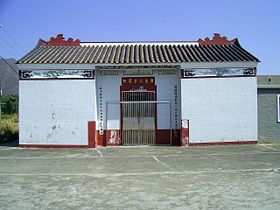- Great Clearance
-
The Great Clearance or Great Evacuation (Chinese: 遷界令; alternatively 遷海令) was ordered in southern China by imperial edicts of the Qing Emperor Kangxi (reigned 1661-1722), then under the regency of Oboi, in 1661 and 1662. It required the evacuation of the coastal areas of Guangdong in order to fight the anti-Qing movement, begun by Ming Dynasty loyalists. The provinces of Shandong, Zhejiang, Jiangsu and Fujian were also affected to varying degrees.[1] The ban was lifted in 1669.
Contents
Purpose
The goal was to fight the anti-Qing movement, begun by Ming Dynasty loyalists under the leadership of Zheng Chenggong (Koxinga), to regain Beijing. The measure was in accordance with a five-point plan to deal with Koxinga, suggested by one of his former lieutenants who had gone over to the Manchus. Its adoption was due to a conviction that Koxinga's compaigning against the new dynasty could not be continued if aid and supplies were denied him in this way.[1]
Xin'an County
Enforcement
Enforcement of this drastic measure was extended to the Xin'an County (which covered roughly the territory of modern-day Shenzhen and Hong Kong) and adjacent counties of Guangdong in 1661. Two inspections determined the areas to be cleared. At the time of the first inspection up to a distance of 50 li from the coast, it was calculated that two-thirds of the territory of the County would be affected. A year later the boundary was extended further inland, and what remained of the County was to be absorbed into the adjoining Dongguan County. By the 5th year of Kangxi, Xin'an had ceased to be a separate administrative county. When the new boundaries were fixed, the inhabitants living outside them were given notice to move inland. These orders were enforced by troops. The result was that whole communities were uprooted from their native place, deprived of their means of livelihood and compelled to settle where they could. The rural people risked their lives if they ignored the government edict to move, or ventured back into the prohibited area. It is recorded that about 16,000 persons from Xin'an were driven inland.[1] What is now the territory of Hong Kong became largely wasteland during the ban.[2]
End of the ban
The ban was lifted in 1669, following a request by the Governor-General of Guangdong and Guangxi Zhou Youde (周有德) and Governor of Guangdong Wang Lairen (王來任), and residents were allowed to return to their original homes.[3] Only 1,648 of those who left are said to have returned when the evacuation was rescinded in 1669.[1]
Legacy
The evacuation of the coast followed prolonged earlier years of miseries and had a profound effect on the lives of the population and on the pattern of future settlement. The survivors' hardships did not end when they returned to take up their interrupted lives in their old homes, for it is recorded that destructive typhoons in 1669 and 1671 destroyed the new houses in many places. The Evacuation has had a great impact on the minds of local people and their descendants. It is recalled in the genealogies and traditions of some of the longsettled clans of the County: it is commemorated in the construction and continued repair of temples to the two officials who strove to have the order rescinded.[1] An example is the Chou Wong Yi Kung Study Hall in Shui Tau Tsuen, in Kam Tin, Hong Kong, which was erected in 1685 by the Tang Clan in honour of Zhou Youde and Wang Lairen.[4] The event was also remembered centuries later by the manufacture and sale by pedlars of images of the two men, as recorded for the Yuen Long District of the New Territories of Hong Kong at the end of the 19th century.[1]
Hakka dialect speaking communities are thought to have arrived in the Hong Kong area after the rescinding of the coastal evacuation order.[5] Their immigration into the area was assisted by the government after the order was rescinded.[1] The formerly established Punti clans also came back, expanded their ancestral halls, built study halls and set up market towns in Yuen Long, Tai Po and Sheung Shui.[2]
Beacon Hill in Hong Kong was named after a beacon, where a garrison was stationed to enforce the decree.[6]
See also
References
- ^ a b c d e f g James Hayes: "The Hong Kong Region: Its Place in Traditional Chinese Historiography and Principal Events Since the Establishment of Hsin-an County in 1573", in Journal of the Royal Asiatic Society Hong Kong Branch, Vol. 14, 1974. pp.108-135
- ^ a b Hong Kong Museum of History: "The Hong Kong Story" Exhibition Materials
- ^ "Towards Urbanisation: Shuen Wan and Plover Cove Reservoir"
- ^ The incredible journey of Yuen Long - Chau Wong Yi Kung Study Hall
- ^ Down to Earth: The Territorial Bond in South China. ed. David Faure & Helen Siu, Stanford University Press. (1995) ISBN 0-8047-2434-2. See p.123-160, in Patrick Hase's article 'Alliance of Ten'.
- ^ Andrew Yanne, Gillis Heller (2009). Signs of a Colonial Era. Hong Kong University Press. p. 119. ISBN 978-9622099449.
Categories:- Qing Dynasty
- 1661 in China
- 1662 in China
- History of Hong Kong
Wikimedia Foundation. 2010.

